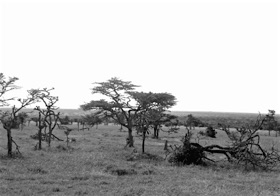Landscape-scale consequences of mutualism disruption: invasive ants threaten a widespread ant-plant mutualism in East Africa.
Mutualisms underlie much of the world's biodiversity and economic productivity. Yet these interactions are increasingly threatened, with consequences that may fundamentally alter the dynamics of ecological systems. While case studies of mutualism disruption accumulate, we have little understanding of the broader consequences of their loss. We are investigating an ongoing disruption by an invasive ant (Pheidole megacephala) of the widespread and foundational ant-Acacia drepanolobium mutualism in Kenya. In this mutualism, aggressive acacia ants protect host trees against herbivores in exchange for domatia and extrafloral nectar. Interactions among trees, acacia ants and large herbivores-elephants in particular-appear to be central determinants of tree cover, which in turn regulates a host of community and ecosystem processes. Our previous work has suggested that, where elephants are present, ant defense deters catastrophic herbivory, which stabilizes savanna tree cover at vast spatial scales. But this protection comes at a high cost, with acacia ants reducing tree growth and reproduction. In areas where P. megacephala has invaded, acacia ants are exterminated from host plants- providing a natural test of the idea that the native ant-acacia mutualism stabilizes tree cover. We hypothesize that effects of this mutualism disruption are context-dependent: where elephants are present, our preliminary data indicate that invaded savannas are undergoing rapid losses of tree cover, as P. megacephala provides no protection to acacias from large herbivores. Since A. drepanolobium is an N-fixer, we predict that these areas will undergo significant reductions in soil and plant N, negatively affecting forage and habitat quality for wildlife. In contrast, where elephants are absent, P. megacephala invasion may accelerate tree growth, as invasive ants do not induce host plant nectar production and thus may reduce metabolic costs to acacias. Over the long-term, we predict this will lead to higher tree cover and soil N in invaded areas. We are evaluating the effects of this mutualism disruption on savanna communities by: (1) quantifying the effects of native vs. invasive ants on growth, N-fixation, reproduction and biomass of trees in the presence and absence of wild herbivores; (2) using demographic models to project tree population growth rates; (3) using remote sensing to assess the rate of spread of the P. megacephala invasion in both wildlife-present and wildlife-extirpated areas; and (4) assessing the effects of P. megacephala invasion on availability of soil and plant nutrients and resulting habitat use by wild herbivores.
To return to the research page, click here



